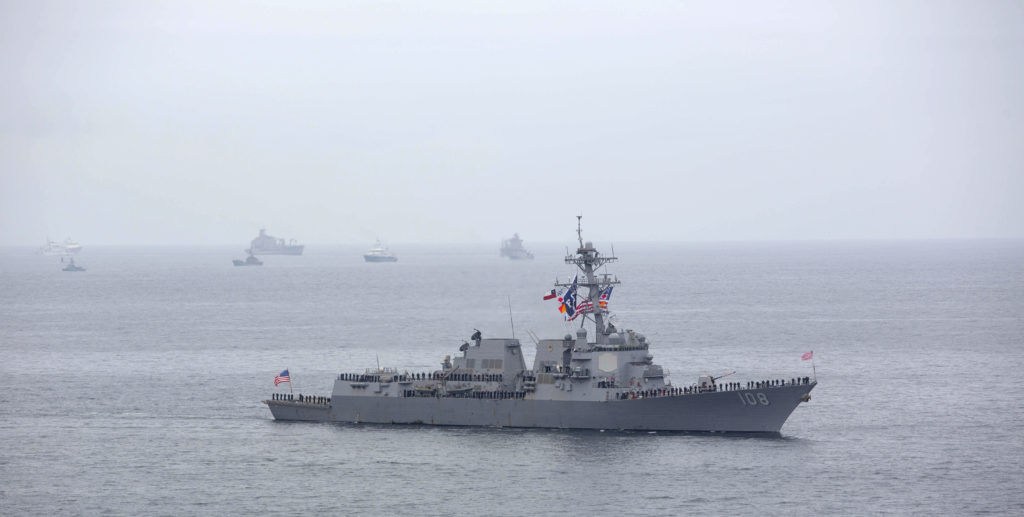
IMAGE: the Arleigh Burke-class guided-missile destroyer USS Wayne E. Meyer (DDG 108) / US NAVY photo
The US Navy deployed a new ship pairing – a destroyer (DDG-51) and an amphibious transport dock (LPD-17), USNI News reported on January 3rd.
The purpose is to test a new concept that could supplement amphibious squadrons and surface action groups as a formation in future operations. It is called the Littoral Combat Group 1 (LCG-1).
“USS Somerset (LPD-25), USS Wayne E. Meyer (DDG-108) and Special Purpose Marine Air-Ground Task Force (SP-MAGTF)-Peru deployed together as Littoral Combat Group 1 in November and December.”
While at sea, the group conducted missions that are typical for both ships: supporting Marines and pushing them ashore, embarking a Coast Guard law enforcement detachment, hosting a surgical team for humanitarian assistance work, and more.
The group’s first voyage was to Valparaiso, Chile, for the Eleventh International Maritime and Naval Exhibition and Conference for Latin America (EXPONAVAL) and the 200th anniversary of the Chilean Navy. Then, the 1,000 sailors and Marines from LCG-1 worked with the Peruvian Naval Infantry in a humanitarian assistance and disaster relief exercise in the disaster-prone Chorrillos district outside Lima.
The two ships also conducted a maritime patrol exercise with Ecuadorian navy assets to counter illegal, unregulated and unreported (IUU) fishing, among other activities.
The goal of the LCG-1 is to put a Navy captain as the commodore of two ships and the SP-MAGTF, similarly to a commodore of “an amphibious squadron (PHIBRON) who oversees an Amphibious Ready Group and Marine Expeditionary Unit, or a destroyer squadron commander (DESRON) commanding a surface action group.”
The focus of the deployment was on command and control and not the actual missions that the ships are capable of conducting together. The Littoral Combat Group could be useful in scenario in which “the DDG firing missiles at an enemy defense system to allow the Marine forces to move ashore, the Marines using their MV-22B aircraft in support of the DDG’s maritime security missions at sea, and so on.”
USNI News cited an anonymous Navy official who said that “Expeditionary Strike Group 3 was the lead on this experimental deployment and will present the command structure and lessons learned to higher headquarters for review.”
LCG-1 was led by Capt. Ken Coleman, the PHIBRON 3 commodore, and included a staff of 30 to 35 on temporary assignment and embarked on Somerset.
“The deployment of LCG-1 was designed to test a command and control concept. Wayne E. Meyer and Somerset were scheduled to participate in EXPONAVAL based on their operational schedules at the time, and LCG-1 provided command and control of those assets under a single commander. The complementary capabilities (brought by the) assigned Navy and Marine Corps units will inform future force development, both in how we organize our naval forces and how we employ them,” 3rd Fleet told USNI News in a written statement.
“In addition to its participation in EXPONAVAL, LCG-1 conducted several partnership training missions while underway and ashore in the [U.S. Southern Command area of responsibility.]”
LCG-1 reported directly to U.S. 3rd Fleet and U.S. 4th Fleet during the deployment, much like a PHIBRON would.
Once the two ships returned home the command was disestablished. The unnamed Navy official said that they would review the learned lessons and consider if they should make a proposal up the chain of command for the establishment of such a pairing.
This is part of the Navy and Marines Corps revision of their concepts to align with the National Defense Strategy, focused on warfare against a peer or near-peer enemy.
“Two key concepts, Distributed Maritime Operations and Littoral Operations in a Contested Environment, are being fleshed out now and will inform upcoming acquisition and exercise efforts in the coming years.”






They do some bizarre things the Americans.
“Two key concepts, Distributed Maritime Operations and Littoral Operations in a Contested Environment, are being fleshed out now and will inform upcoming acquisition and exercise efforts in the coming years.”
Translated from Moron Speak the concept is :-
‘ Naval combat operations close to shore will combine ships with fire support abilities in opposed Marine troop landings ‘.
The immense US military brain who discovered this ‘novel’ concept should be promoted immediately.
He/she/it could even make President one day :)